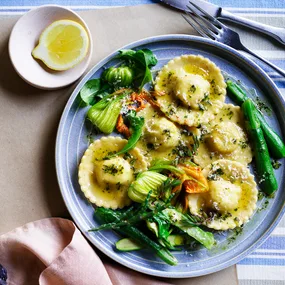Crustaceans can be tricky creatures to prepare and cook at home, but we show you how to enjoy a fantastically fresh lobster with a clear conscience.
Killing your own lunch isn’t for everybody. While, ethically speaking, it’s important to acknowledge the fact that a creature is giving up its life for your eating pleasure, there’s a lot to be said for the ‘out of sight, out of mind’ argument. But there are times, purely for freshness, taste and texture, when you have to bite the bullet and take matters into your own hands. Literally. This is where we’re at when it comes to preparing a lobster from scratch.
Once you’ve arrived at this decision, the key consideration should be to kill it as quickly and as humanely as possible.
So what do you look for in your live lobster? For starters, it should be lively and heavy for its size when picked up. You should also cook it as close to purchase as possible; keep it in a cool place covered with a damp cloth in the meantime, and make sure the cloth stays damp.
When it’s time to cook the lobster, the RSPCA recommends you chill it in the air of a fridge or freezer to slow its metabolism, and then dispatch it by spiking or splitting. (Live crustaceans should never be boiled without first being chilled to render them insensible.) Practically speaking, this means you should put them in the freezer for half an hour, then push a large kitchen knife into the space between the body and head to sever their nerves, or split the lobster cleanly down the middle.
If you’re going to boil your lobster, salt the water heavily (about ½ cup of salt for every 2.5 litres of water). As with most seafood, the cooking water should taste of the sea – in fact, many cooks like to use seawater to cook their lobster.
We’ve cooked a 1kg lobster in the recipe here; if you prefer a smaller or larger lobster, adjust the cooking time. A 500gm lobster will take about 12 minutes to cook, then 10 minutes for the next 500gm, then about 5 minutes per 500gm after that. After cooking, leave it to cool without rinsing it. The intact shell prevents the meat from drying out and also helps it to maintain its sea flavour.
There are plenty of wonderful things that can be done with lobster shells, too (and, given the expense, you might as well make the most of it). They make great bases for soups; rich bisques in winter and chilled consommés in summer. They can flavour sauces, oils and dressings, as with the lobster mayo we’ve done here. And the glorious tomalley or ‘mustard’ in the head is packed full of intense lobster flavour, but it is something of an acquired taste.
The rewards of preparing a lobster from scratch are many. Compared to the tough and flavourless lobster you buy ready-cooked or frozen from fish-mongers, fresh lobster is unbeatable: the flavour is strong and the texture is soft and delicate. Enjoy with a good bottle of white and a clear conscience.










